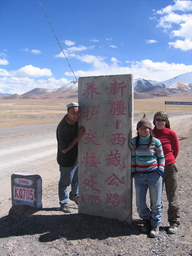
Xinjiang/Tibet
Boundary Marker
2005.09.18 Ali, Tibet
 Xinjiang/Tibet Boundary Marker |
We've made it into Tibet.
I'll keep this update brief. Since leaving Kashgar I've been maintaining a pen-and-paper log. When I have better Internet access I'll post those entries, most of which describe the road journey we've just completed.
In short, Nisagul, Tiffany, and I managed to get a lift in a truck from Xinjiang to Tibet. The overall distance was not far: just over 1,000 kilometers. However, given the circumstances this worked out to a journey of several days. The road crosses several mountain passes, two at 5,250 meters. The truck was overloaded with lumber and woven mats, making for slow ascents. Several times the truck had a mechanical problem which forced us to stop: the radiator boiled over once, we changed tires several times.
The slow pace of the trip was fine with us--it would be hard to find a more spectacular setting. That road is the highest road in the world. Much of the way is desert, sprinkled with peaks of the Kunlun mountain range. There's not much animal life or human population en route. I do recall seeing a herd of yak on the second day of the trip; entering the Tibetan plateau we saw four antelope dashing across our path. Nights have been spent in sparse settlements that exist solely to support the road.
The town we're currently in, Ali, is something of a surprise. It's the same as any small Chinese city elsewhere in the country, with blocky tiled buildings, taxis running up and down the streets, and a large population of recent Chinese migrants from poorer provinces. Ali is certainly not unique for these characteristics--it's just surprising to find that a city like this can function when so cut off from the rest of the country. I don't believe there is any sort of airstrip nearby: all goods have to be trucked in by road. The road out of Ali goes either westward to Kashgar, or eastward on to Lhasa, an even greater distance than we have just traveled.
Despite the uniformity of Ali's features with every other city across China, there are some hints that this is now Tibet. Rather than the Arabic script of the Uighur alphabet doubling with Chinese characters, as in Xinjiang, local shop signs have Tibetan running along the top. Every so often I've seen a passer-by idly twirling a prayer-wheel. Outside our hotel I saw a couple of Buddhist nuns chatting with each other, heads shaven, clad in crimson robes. Shops here have a fair percentage of goods imported from the subcontinent, as well as local specialties, such as yak butter.
We're currently looking into moving along, getting a lift to somewhere near Mount Kailash. I'll update this site with my entries from the road journey and photos whenever Internet access next allows.